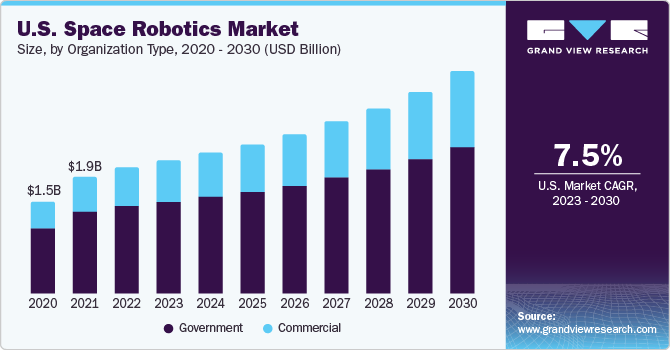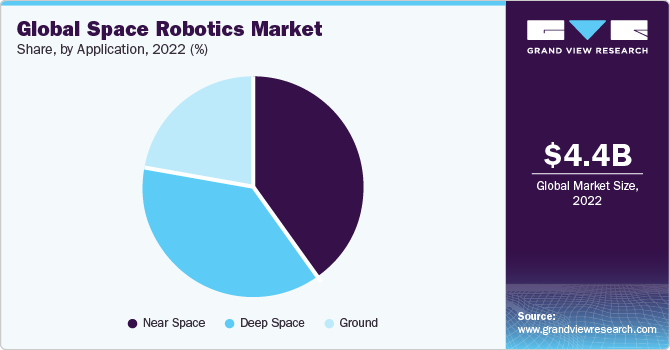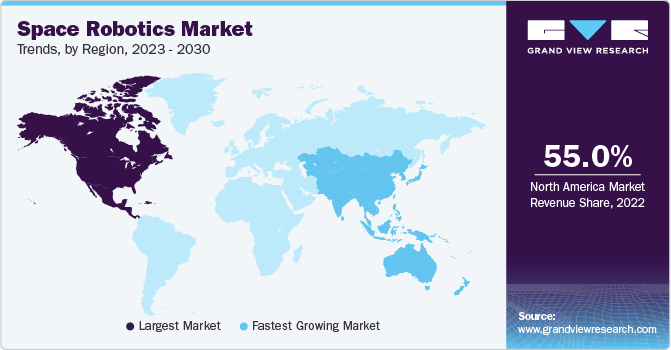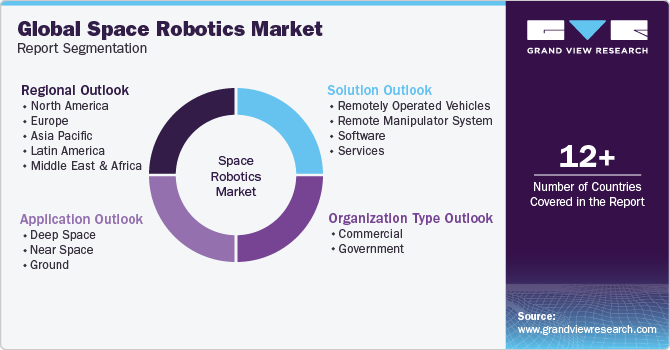- Home
- »
- Next Generation Technologies
- »
-
Space Robotics Market Size & Share Analysis Report, 2030GVR Report cover
![Space Robotics Market Size, Share & Trends Report]()
Space Robotics Market Size, Share & Trends Analysis Report By Solution (Services, ROVs), By Application (Near Space, Deep Space), By Organization Type (Commercial, Government), By Region, And Segment Forecasts, 2023 - 2030
- Report ID: GVR-4-68038-256-3
- Number of Report Pages: 115
- Format: PDF, Horizon Databook
- Historical Range: 2017 - 2021
- Forecast Period: 2023 - 2030
- Industry: Technology
Space Robotics Market Size & Trends
The global space robotics market size was valued at USD 4.40 billion in 2022 and is anticipated to grow at a compound annual growth rate (CAGR) of 8.8% from 2023 to 2030. The need for efficient repair, service, and maintenance of geostationary satellites is bolstering the demand for space robots. Cost-effectiveness, better productivity, and the ability to perform in the extreme space environment are the prime factors driving the demand for space robotics technology. Moreover, the successful implementation of future space programs, such as on-orbit manufacturing and assembly in the International Space Station (ISS) and the lunar surface innovation initiative by the National Aeronautics and Space Administration (NASA), requires sophisticated robotics systems.

Factors such as technological developments, the growing use of autonomous systems in space, and an increasing number of space programs are expected to contribute to market growth. NASA has identified several robotics areas that are required in its space technology roadmap to 2035. Similarly, the European Space Agency (ESA) is planning technology roadmaps in space robotics through funding several projects by the European Commission, such as PERASPERA and SpacePlan 2020. Project PERASPERA aims to develop an integrated master plan for space robotics technology within the 2023-2024 timeframe. Other nations, such as China, Russia, India, and Japan, also announced their space programs involving robotics technology.
Robotics and autonomous systems are instrumental in the current and future space exploration missions. Space robots are mission-defined machines capable of performing several tasks, such as exploration, satellite servicing, and maintenance. The robots extend the human ability to operate and explore in space by providing greater handling capabilities to astronauts. Modern space robots represent a multi-disciplinary approach in the field of engineering and space science. As a result, the application base of space robotics technology has widened, ranging from assisting the crew to autonomously operating on a new planetary surface.
Emerging technologies, such as Artificial Intelligence (AI) and Deep Learning (DL), are widely being used in the robotics industry. Several organizations are developing AI-based robots that provide greater exploration benefits and enhanced mobility in space. These robots can operate with minimum human aid and perform highly complex tasks for a longer duration. For instance, in June 2023, the International Space Station (ISS) started utilizing a new tool known as Int-Ball, designed by the Japan Aerospace Exploration Agency and controlled & monitored by a team of JAXA ground controllers. The primary purpose of Int-Ball is to reduce the time required for shooting videos/photos; JAXA has developed the JEM Internal Ball Camera ("Int-Ball") that moves autonomously to the desired spatial position and shoots videos/pictures of the subject, ultimately aiming to realize zero photographing time by the crew.
The increasing growth in satellite launches fuels the demand for on-orbit servicing and assembling, increasing the demand for robotics. Furthermore, because of the high number of satellites carried into orbit in the past decades, the space environment surrounding the Earth has been heavily chaotic, with fragments becoming an increasing endangerment for current and future space missions. Such conditions have increased the demand for robotics for active debris removal and servicing in orbit. In addition to In-Space Robotic Assembly (ISRA) and Extra-Vehicular Activity (EVA), dexterous robotic manipulators are being utilized to capture, maintain, and de-orbit defective and operational satellites. With the growth of such missions, the demand for space robotics is expected to elevate in the near future.
Moreover, with the increase in space exploration programs, satellite data is increasing. Managing such huge data is difficult and requires additional technologies such as AI and ML. A single robot used in planetary exploration is not able to cover wider or topologically different areas to acquire all the required information. Such challenges are expected to give rise to multi-robot systems. Using multiple robots will allow increasing locomotion by combining several specialized vehicles to explore planetary missions. The usage and adoption of such a multi-robot system are expected to drive the market soon.
With recent technological advancements, the expedition to space and related activities has become ever-exciting. However, discovering space is quite risky and complicated. For instance, having complete know-how about the atmosphere, surface conditions, temperature, and soil composition excites engineers, astronauts, scientists, and space agencies to explore more, but not at the cost of humans. This is where robotics solutions come into the picture as a way out. Autonomous systems and robotics play an instrumental role in the current and future space exploration missions. The national space agencies, such as Roscosmos State Corporation for Space Activities (Russia), the ESA, NASA in the U.S., China National Space Administration, the Japan Aerospace Exploration Agency, and the ISRO, are capitalizing on various space robotics projects for maintaining and servicing, along with scaling the space exploration activities. The robotic solutions improve the ability of astronauts to operate and explore in space by providing them with better handling capabilities.
Application Insights
The near space segment accounted for the largest revenue share of around 40.5% in 2022. Near-space or orbital robots can be used for repairing satellites, assembling large space telescopes, and deploying assets in space for scientific exploration. The near-space segment is further segmented into space transportation and exploration, in-space maintenance, and others. The space transportation segment is expected to exhibit a strong growth rate over the forecast period owing to the demand for resupply for the ISS and servicing the existing geosynchronous satellites.

The deep space segment is estimated to register the fastest growth with a CAGR of 10.3% over the forecast period. Deep space robots or planetary robots play a vital role in observing, surveying, and extracting extra-terrestrial surfaces. The robotic system is crucial for deep space exploration programs to extend human reach into space, expand planetary access capabilities, and enhance human operation efficiency by supporting the astronaut crew in space operations. Exploration robots, autonomous spacecraft, human-assistive robots, and piloted aircraft are some robotic systems gaining momentum in the market.
Solutions Insights
The Remotely Operated Vehicles (ROV) segment accounted for the largest revenue share of 37.6% in 2022 and is expected to expand at the fastest CAGR during the forecast period. The ROVs segment is further categorized into rovers/spacecraft landers, space probes, and others. Rovers are planetary surface exploration robots that are designed to perform several tasks, such as image capturing, planet exploration, digging, and data analysis & and transmission. The upcoming space missions, such as Luna 25 by Roscosmos, Spacebit Mission One by the U.K., ALINA by Germany, and Mission One by NASA, are expected to drive the demand for rovers/spacecraft landers.
The remote manipulator system (RMS) segment is expected to expand at a significant rate during the forecast period. RMS can retrieve, deploy, and handle satellite payloads and assist astronauts in maintenance activities. The growing demand for space-based services, such as satellite servicing, surface mobility, de-orbiting services, and re-supply services, is expected to propel the RMS segment growth. RMS is further segmented into robotic arms/manipulator systems, gripping & and docking systems, and others. Robotic arms are poised to witness significant growth in advanced space systems as they assist astronauts in lifting and handling heavy objects in space. Canadarm and Dextre are the two robotic arms presently attached to ISS.
Regional Insights
North America dominated the space robotics industry and accounted for the largest revenue share of 55.0% in 2022. The regional market growth is attributed to the strong space capabilities of NASA and CSA. The regional market growth is attributed to the strong space capabilities of NASA and CSA. Both organizations invest huge amounts in R&D and technology enhancement to execute space exploration initiatives.

NASA is looking to build in-space infrastructure for long-term space exploration and develop a lunar gateway. This can be achieved by developing a complex lunar robotic mission. Moreover, this gateway provides the opportunity for commercial missions to the moon's surface, which will help pioneer new technologies, such as robotic precursors for future human missions beyond Earth’s orbit, spaceflight systems, and crew mobility. All these space and moon exploration projects add up to the industry development prospect.
Canada is at the forefront of delivering robotic arms to the space station. The country has given two robotic arms: Canadarm and Canadarm2. The country is working on developing Canadaarm3, which is expected to be launched by 2026. Developments in mobility and manipulation, robotic sensing & and perception, onboard & and ground-based autonomous capabilities, and human-robot integration are expected to drive the market over the forecast period.
Asia Pacific is expected to expand at the fastest CAGR of 10.2% during the forecast period Asia Pacific is the first region to adopt a correlation approach using geospatial information services and space technology to enhance resilience and mitigate disaster risk. The countries from the region are expected to work collaboratively through a regional action plan for a sustainable future. This helps countries with limited space capabilities, such as Mongolia, work with space technology leaders like China, India, and Japan. Moreover, the upcoming space programs and exploration missions, such as Chandrayaan-3 by India and Chang'e 7 robotic lunar exploration missions by China, are expected to provide a new horizon to the regional market.
Europe is also expected to witness a prominent growth rate over the forecast period. The ESA has been developing technology roadmaps in RAS through various European Commission-funded projects such as SpacePlan 2020 and PERASPERA. The international space community widely acknowledges numerous technological needs or challenges in RAS. Technological developments, automation in space, and a cumulative number of space programs are expected to contribute to market growth.
Organization Type Insights
The government segment held the largest revenue share of 69.5% in 2022. Several R&D activities and satellite launches for defense & and security purposes are escalating the demand for robotics technologies in this segment. Moreover, increasing emphasis on space and satellite technology for military & defense activities is driving the segment growth. Various governments are also funding R&D activities related to space and robotics applications. For instance, in February 2023, the union budget for India 2023-2024 allocated USD 151.48 million for the Department of Space (DoS). It is expected to help the growth of India's space program by launching projects ranging from launch vehicles and satellites to other developmental and operational ones.
The commercial segment is expected to expand at the fastest CAGR of 9.0% over the forecast period as commercial investments in space missions are increasing gradually. Private companies are continuing their successful mission to low Earth orbit, providing space transportation and space & flight support to the International Space Station. The surge in demand for satellite servicing, refueling, and mission extension services provides new business opportunities to private companies.
Moreover, NASA is planning to end direct federal funding for the ISS by 2025 and adopt a commercial approach associating several commercial partners to the Moon and Mars missions. In June 2020, the government of India announced the formation of the Indian National Space Promotion and Authorization Centre (IN-SPACe) to promote and guide private companies in the space business through favorable policies and an encouraging regulatory environment. As a result, a new business model and space capabilities are expected to emerge in the private sector.
NASA awarded contracts worth USD 370 million to private companies for the moon exploration project. The contract is awarded to 14 companies, including Lockheed Martin, United Launch Alliance, Intuitive Machines, Astrobotic, and SpaceX. Among these, Intuitive Machines is working on a robotic mission to the lunar surface, which is expected to be launched in 2024. All these factors are expected to drive the growth of the commercial segment over the forecast period.
Key Companies & Market Share Insights
The competitive landscape of the market is changing rapidly. The conventional national organizations, such as NASA and ESA, are the market’s principal entities. However, commercial enterprises have showcased their intent and are entering the arena. Commercial enterprises are developing the means for space exploration and exploitation missions. The Mars mission by SpaceX, asteroid mining by Bradford Space, and space tourism by Blue Origin are the commercial programs by private entities. Moreover, the participation of private players in the space industry can reduce the investment burden and enhance innovation. As a result, government organizations, such as NASA and ESA, are collaborating with the private firms for their space programs.
Market players focus on inorganic growth strategies, such as acquisitions & mergers, and collaborations, to augment their market share. For instance, in April 2023, during the spring Lunar Surface Innovation Consortium (LSIC), ASTROBOTIC technology declared its third future lunar lander mission will use launch services on a SpaceX Falcon Heavy rocket. In 2026, this mission is expected to send an Astrobotic lander to the moon’s south pole with a payload of experiments and goods from worldwide.
Key Space Robotics Companies:
- ALTIUS SPACE MACHINES.
- ASTROBOTIC TECHNOLOGY
- BluHaptics, Inc.
- Honeybee Robotics
- Intuitive Machines, LLC.
- MAXAR TECHNOLOGIES
- Metecs, LLC.
- Motiv Space Systems, Inc.
- Northrop Grumman.
- Oceaneering International, Inc.
Recent Developments
-
In March 2023, Honeybee Robotics, LLC, announced the opening of a new office in Greenbelt, Maryland. The facility focuses on engineering and program management, featuring state-of-the-art equipment for efficient hardware development.
-
In November 2022, NASA chose Honeybee Robotics to design, build, and deploy the Spin Eject Mechanics (SEM) on the Mars Sample Return Mission (MSR). During launch, cruise, and on-orbit operations around Mars, the SEM was planned to control the Earth Entry System (EES). However, SEM's primary duty is to release the EES from the MSR Earth Return Orbiter spacecraft.
-
In October 2021, the Japanese space robotics start-up GITAI declared that it carried out a technical demonstration of an autonomous space robot inside the ISS (International Space Station), performing various tasks. NASA plans to place the robot inside the NanoRacks Bishop Airlock at the ISS after a successful technical demonstration.
Space Robotics Market Report Scope
Report Attribute
Details
Market size value in 2023
USD 4.70 billion
Revenue forecast in 2030
USD 8.48 billion
Growth rate
CAGR of 8.8% from 2023 to 2030
Base year for estimation
2022
Historical data
2017 - 2021
Forecast period
2023 - 2030
Report updated
November 2023
Quantitative units
Revenue in USD million/billion, and CAGR from 2023 to 2030
Report coverage
Revenue forecast, company ranking, competitive landscape, growth factors, and trends
Segments covered
Solution, application, organization type, region
Regional scope
North America; Europe; Asia Pacific; Latin America; MEA
Country scope
U.S.; Canada; UK; Germany; France; China; Japan; India; Australia; South Korea; Brazil; Mexico; Saudi Arabia; South Africa; UAE
Key companies profiled
ALTIUS SPACE MACHINES.; ASTROBOTIC TECHNOLOGY; BluHaptics, Inc.; Honeybee Robotics; Intuitive Machines, LLC.; MAXAR TECHNOLOGIES; Metecs, LLC.; Motiv Space Systems, Inc.; Northrop Grumman.; Oceaneering International, Inc.
Customization scope
Free report customization (equivalent up to 8 analyst’s working days) with purchase. Addition or alteration to country, regional & segment scope
Pricing and purchase options
Avail customized purchase options to meet your exact research needs. Explore purchase options
Global Space Robotics Market Report Segmentation
This report forecasts revenue growth at global, regional, and country levels and provides an analysis of the latest industry trends in each of the sub-segments from 2017 to 2030. For this study, Grand View Research has segmented the global space robotics market report based on solution, application, organization type, and region:

-
Solution Outlook (Revenue, USD Million, 2017 - 2030)
-
Remotely Operated Vehicles (ROV)
-
Rovers/Spacecraft Landers
-
Space Probes
-
Others
-
-
Remote Manipulator System (RMS)
-
Robotic Arms/Manipulator Systems
-
Gripping & Docking Systems
-
Others
-
-
Software
-
Services
-
-
Application Outlook (Revenue, USD Million, 2017 - 2030)
-
Deep Space
-
Space Transportation
-
Space Exploration
-
Others
-
-
Near Space
-
Space Transportation
-
Space Exploration
-
In-space Maintenance
-
Others
-
-
Ground
-
-
Organization Type Outlook (Revenue, USD Million, 2017 - 2030)
-
Commercial
-
Government
-
-
Regional Outlook (Revenue, USD Million, 2017 - 2030)
-
North America
-
U.S.
-
Canada
-
-
Europe
-
Germany
-
UK
-
France
-
-
Asia Pacific
-
China
-
Japan
-
India
-
Australia
-
South Korea
-
-
Latin America
-
Brazil
-
Mexico
-
-
Middle East & Africa
-
Saudi Arabia
-
South Africa
-
UAE
-
-
Frequently Asked Questions About This Report
b. The global space robotics market size was estimated at USD 4.40 billion in 2022 and is expected to reach USD 4.70 billion in 2023.
b. The global space robotics market is expected to grow at a compound annual growth rate of 8.8% from 2023 to 2030 to reach USD 8.48 billion by 2030.
b. North America dominated the space robotics market with a share of 55.0% in 2022. This can be attributed to the high demand for space robotics activities from prominent organizations, such as NASA and the Department of Defense due to the increasing reliance on space assets and for enabling safety in space operations.
b. Some key players operating in the space robotics market include Maxar Technologies, Motiv Space Systems, Inc., Altius Space Machines, Northrop Grumman, Honeybee Robotics, Astrobotic Technology, Made In Space, and Effective Space Solutions Limited.
b. Key factors that are driving the space robotics market growth include the growing demand for servicing existing geostationary satellites, debris removal, and technological advancements in autonomous systems.
Share this report with your colleague or friend.
![gvr icn]()
NEED A CUSTOM REPORT?
We can customize every report - free of charge - including purchasing stand-alone sections or country-level reports, as well as offer affordable discounts for start-ups & universities. Contact us now
![Certified Icon]()
We are GDPR and CCPA compliant! Your transaction & personal information is safe and secure. For more details, please read our privacy policy.
We are committed towards customer satisfaction, and quality service.
"The quality of research they have done for us has been excellent."





